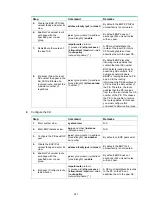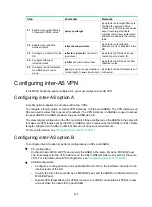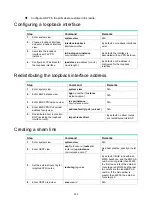
229
Step Command
Remarks
13.
Enter BGP instance view.
bgp
as-number
[
instance
instance-name
]
N/A
14.
Configure the PE in the same
AS as an IBGP peer.
peer
{
group-name
|
ipv4-address
[
mask-length
] }
as-number
as-number
By default, no BGP peers exist.
15.
Configure the ASBR in
another AS as an EBGP
peer.
peer
{
group-name
|
ipv4-address
[
mask-length
] }
as-number
as-number
By default, no BGP peers exist.
16.
Create the BGP IPv4 unicast
address family and enter its
view.
address-family ipv4
[
unicast
]
By default, the BGP IPv4 unicast
address family is not created.
17.
Enable exchange of IPv4
unicast routes with the PE in
the same AS and the ASBR
in another AS.
peer
{
group-name
|
ipv4-address
[
mask-length
] }
enable
By default, BGP does not
exchange IPv4 unicast routes with
any peer.
18.
Enable exchange of labeled
IPv4 routes with the PE in the
same AS and the ASBR in
another AS.
peer
{
group-name
|
ipv4-address
[
mask-length
] }
label-route-capability
By default, BGP cannot advertise
labeled routes to any IPv4 peer or
peer group.
19.
Configure the ASBR to set
itself as the next hop of
routes advertised to the PE
in the local AS.
peer
{
group-name
|
ipv4-address
[
mask-length
] }
next-hop-local
By default, BGP does not use its
address as the next hop of routes
advertised to an IBGP peer or
peer group.
20.
(Optional.) Apply a routing
policy to routes incoming
from or outgoing to a peer or
peer group.
peer
{
group-name
|
ipv4-address
[
mask-length
] }
route-policy
route-policy-name
{
export
|
import
}
By default, no routing policy is
applied.
Configuring nested VPN
For a network with many VPNs, nested VPN is a good solution to implement layered management of
VPNs and to conceal the deployment of internal VPNs.
To build a nested VPN network, perform the following configurations:
•
Configurations between customer PE and customer CE
—Configure VPN instances on the
customer PE and configure route exchange between customer PE and customer CE.
•
Configurations between customer PE and provider CE
—Configure BGP VPNv4 route
exchange between them. To make sure the provider CE can receive all VPNv4 routes,
configure the
undo policy vpn-target
command on the provider CE to not filter VPNv4 routes
by RTs.
•
Configurations between provider CE and provider PE
—Configure VPN instances and
enable nested VPN on the provider PE and configure BGP VPNv4 route exchange between the
provider CE and provider PE.
•
Configurations between provider PEs
—Configure BGP VPNv4 route exchange between
them.
Nested VPN allows a customer PE to directly exchange VPNv4 routes with a provider PE, without
needing to deploy a provider CE. In this case, the customer PE also acts as the provider CE.
Therefore, you must configure provider CE settings on it.
Configurations on the customer CE, customer PE, and provider CE are similar to basic MPLS
L3VPN configurations. This task describes the configurations on the provider PE.
When you configure nested VPN, follow these guidelines:






























